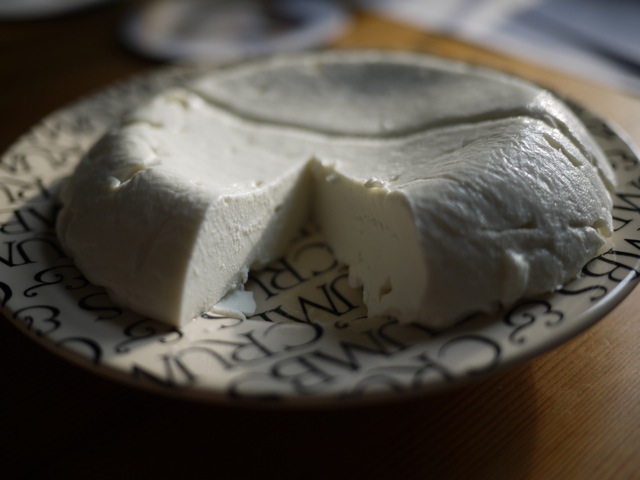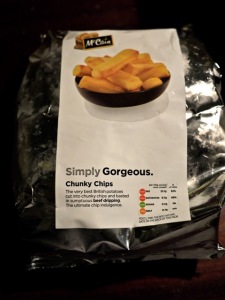A few weeks ago the nice people at Kent & Fraser asked me if I wanted to try some of their gluten free biscuits.
Hidden words
Last week I was walking from Holborn to near Oxford Circus.
I went past the works going on at Tottenham Court Road. I saw these words painted high up on the side of the building.
Not visible until now.
And they’ll be hidden again soon. But they’ll still be there.Playing with colour
I’ve been doing some bits and pieces of web design recently in WordPress.
One of the tools I really like for picking colour schemes or playing with palettes is Color Scheme Designer.
There’s hours of endless fun to be had coming up with bonkers schemes.
And of course it is very helpful when you need to design a scheme or adapt one for some one.
In Season: Cheese and Onion
This article was first published in Francoise Murat & Associates newsletter in March 2010.
Mention cheese and onion and most people think of crisps. My quick Twitter survey revealed answers naming the Walkers brand, the colour of their bags (blue apparently) and even Gary Linekar, the face of Walkers crisps for so long he must surely have earned more from promoting crisps than from playing football and being a pundit. A few people were more inventive suggesting pasties and toasties but for most it was all about the crisps. The reason the crisp flavour works well is that the milky sour tang of cheese and the pungency of alliums are happy bedfellows, which means they have lots to offer in the kitchen, and spring is when plenty of both are at their best, real cheeses and real alliums, not Walkers crisps.
Thinking about the combination a whole host of dishes come to mind: leek and cheese sauce for pasta or chicken, onion soup with a lovely melting cheese crouton, cheese with pickled onions, cheese and onion marmalade sandwich, fresh goats cheese with chives, Yarg cheese wrapped in wild garlic, omelettes, frittatas or flans in a variety of allium and cheese combinations. The possibilities are endless.
British grown alliums are at their best now, lovely slim tender delicate leeks, new season spring onions, regular onions, shallots and of course wild garlic. Wild garlic has become an ‘on trend’ ingredient in the last couple of years as foraging has grown in popularity. It’s easy to find (the smell is a giveaway) particularly in woods by streams, you can grow it in your garden in a shady spot (but beware of it taking over) and you might see it at farmers’ markets or farm shops. You can eat the leaves and the flowers but like any allium it can range from mild to blow your head off in strength so always taste a little first before deciding how to use it. If you go foraging make sure you aren’t on private land or ask permission first, don’t collect from close to busy roads and be sure you know what it is you’ve picked. Don’t dig it up, leave enough for others to have some and for the plant to survive next year. The flowers are pretty sprinkled on salads and the leaves make a good substitute for leeks or spring onions.
As for cheese, fresh cheeses are particularly tasty in the spring as herds start to feed on grass again enriching the milk with clean herby flavours. Britain has a wealth of artisan cheeses and you should be able to find at least at one or two fresh cheeses in delis and farm shops. If you can’t then why not do a little experimenting in the kitchen and try making your own curd style cheese. It’s very simple to do and works with all types of fresh milk: cow’s, goat, sheep, even buffalo. Unpasteurised milk is lovely but normal works fine. This method is quick and easy and good as a supervised experiment for children. The yield varies depending on the milk, its highest with buffalo and lower with cow’s milk but whatever you choose you’ll get a lovely fresh delicious cheese. You can use the leftover whey in bread making in place of some of the milk or water.
Fresh cheese
Adapted from a recipe in the Casa Moro Cookbook by Sam & Sam Clark.
Ingredients:
- 750ml milk
- 1 tbsp essence of rennet (note that essence of rennet has already been diluted if you use undiluted rennet you must dilute it with water first)
Method:
- Warm the milk to between 32-37C.
- Add rennet and stir.
- Pour into a bowl and cover with cling film.
- Leave in a warm place for 30-45 minutes.
- The curds will have set so cut them into about 3cm cubes whilst still in the bowl. Be gentle.
- Leave for a further hour in a warm place.
- Strain the curds into a muslin-lined colander.
- Leave for about 6 hours for the whey to drain.
It’s as simple as that. The cheese will keep for up to a week in the fridge. It’s very mild in flavour and is particularly good rolled in some finely chopped wild garlic leaves or other fresh herbs. It also works well in omelettes, flans, and frittatas and stirred into pasta, with alliums of course and maybe a little mustard.
So next time you think of cheese and onion go beyond the immediate thought of a crisp flavour and branch out a bit in the kitchen.
On blogging, writing, twittering…
Even after a year on Twitter I still find the connections you make amazing and surreal at the same time. I guess its true of any kind of networking that if you put effort in and talk to people then you’ll have some great opportunities present themselves. I’ve meet a whole lot of fascinating people, some I’ve only talked to on Twitter so far but plenty I’ve met in the ‘real’ world as well. So I’ll be carrying on tweeting (and other online networking) and hoping to meet more.
One opportunity that came up recently was the chance to write articles somewhere other than here on my blog. I was thrilled. I don’t think I really thought about why I started my blog in January 2009, I just did. Well that’s not quite true a very good friend and (ex)colleague said over lunch:
‘If you say one more time that you want to do something with your love of food and don’t do anything about it I’ll dump you as a mate.’
I kind of hope he wouldn’t have dumped me but it did spur me into action, well at least to writing the blog and then other things unfolded from there. I have to say that writing for others wasn’t particularly on my list of places it might take me, so it was nice to have someone think my writing was what they needed for their newsletter that goes to 6000 people every two weeks. I’m sharing the writing with Helen from A Forkful of Spaghetti, we’ll be trying to alternate each newsletter so that the readers get a different outlook. We’ll be talking about what’s in season and trying to highlight the best of local British produce, things very dear to my heart when it comes to food.
So without further ado I’d like to say a big big shout for Francoise Murat for asking me to contribute to her company’s newsletters. Its very nice to see my writing sitting alongside articles about garden and interior design, two things I love but rarely touch on here, after all this is all about the food.
I’ll post each piece on the blog close to when it goes out but if you like gardens and interiors then you should at the very least take a look at Francoise’s website and follow her on Twitter.
Website: http://www.francoisemurat.com/
Twitter: http://twitter.com/FrancoiseM
Cheat Chips
I know its really bad.
Chips are bad aren’t they anyway. And to cheat as well. That’s doubly bad.
Surely I should make my own. But why would I bother when I can have these.
Because they really are very good. Nearly as good as my Grandma used to make and she made amazing chips.
I reckon its the beef dripping.
And all with no boiling oil. Fat fires. Or smelly house. Its genius I tell you. Genius.
Pie-aggio: A day at the races
Ever since tasting Brays Cottage pork pies I’ve been avidly following what they are up to on Twitter in the hope that they will be coming to a stockist near me soon.
Today that hope got a teeny bit nearer when they launched their Pie-aggio van at Fakenham Races.
I’m not sure its quite up to a trip to London but I’m dreaming they’ll launch a fleet of them to brings pies to the whole country.
Meanwhile I shall be looking out for it if I venture up to Norfolk.






